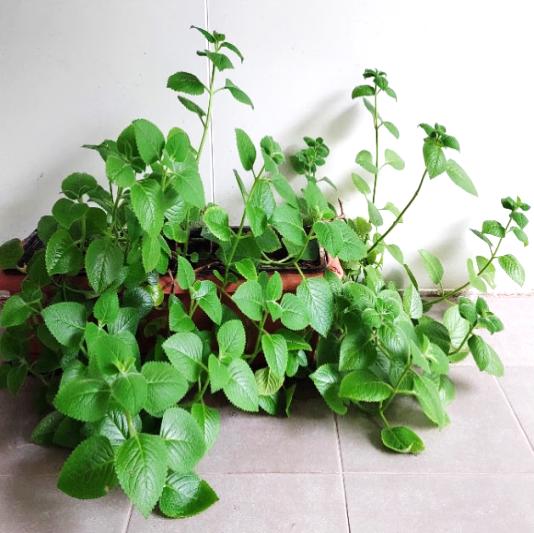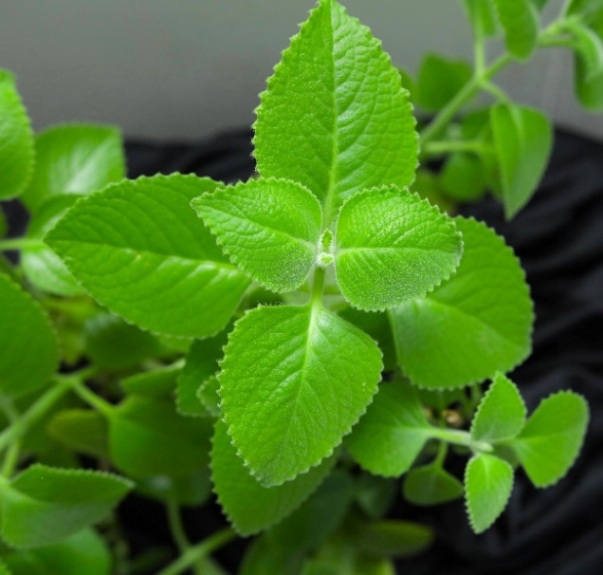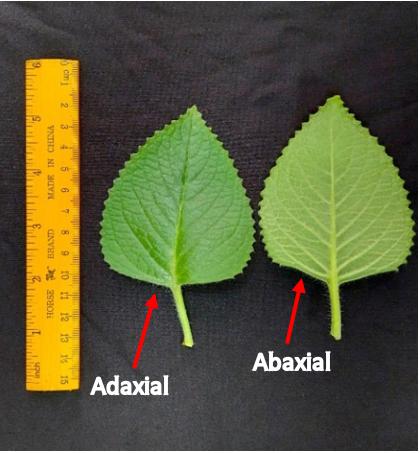Bangun-bangun Leaves
Plectranthus amboinicus (Lour.) Spreng
Lamiaceae
DEFINITION
Bangun-bangun leaves consist of the powder of dried leaves of Plectranthus amboinicus (Lamiaceae).
SYNONYM
Coleus amboinicus Lou., Coleus amboinicus var. violaceus Gürke., Coleus aromaticus Benth., Coleus carnosus Hassk., Coleus crassifolius Benth., Coleus subfrutectosus Summerh., Coleus suborbicularis Zoll. & Moritzi, Coleus suganda Blanco, Coleus vaalae (Forssk.) Deflers., Majana amboinica (Lour.) Kuntze., Majana carnosa (Hassk.) Kuntze., Majana suganda (Blanco) Kuntze., Ocimum vaalae Forssk. [1]
VERNACULAR NAMES
Mexican mint, spanish thyme, cuban oregano, indian borage (English); bebangun, bangun-bangun, mangun-mangun (Malay); zuo shou xiang, yin du bo he, dao shou xiang (Chinese); karpuravalli (Tamil) [2, 3, 4, 5].
CHARACTER
| Colour | Brownish green |
| Odour | Characteristic |
| Taste | Minty taste |
IDENTIFICATION
Plant morphology
P. amboinicus is perennial herb with a life cycle of 3–10 years, fleshy and highly aromatic. It has a tendency to climb or creep, and can reach up to 1–1.2 m tall. Leaves simple, thick and fleshy, light green with opposite leaf arrangement (2.5–3cm long, 2.5–3 cm wide), broadly ovate or triangular in shape (truncate leaf base and a broadly acute apex); leaf margin is crenate; lower surface contains numerous glandular hairs, giving a frosty appearance. Stems are tomentose (densely covered with short, soft hairs). A verticil inflorescence contains 10 to 20 flowers, 10–20 cm long. Flowers encircle the floral stalk at several points along the floral stalk, with points closer together at the tip than at the base; calyx is bell shaped. Fruits are smooth nutlets, pale brown in colour [2, 5].
Microscopy
Powdered material consists of the fragments of parenchyma cells; annular, and spiral vessels; stomata cell; abundant of calcium oxalate crystals (solitary and druse form). Other features observed include the presence of capitate glandular trichomes (terminal: rounded, tapering and multicellular) and non-glandular (e.g. simple, uniseriate), echinate feature on the surface present; and oil globules.

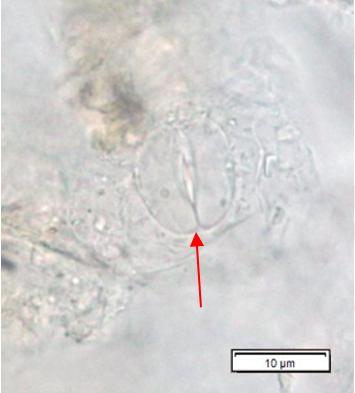
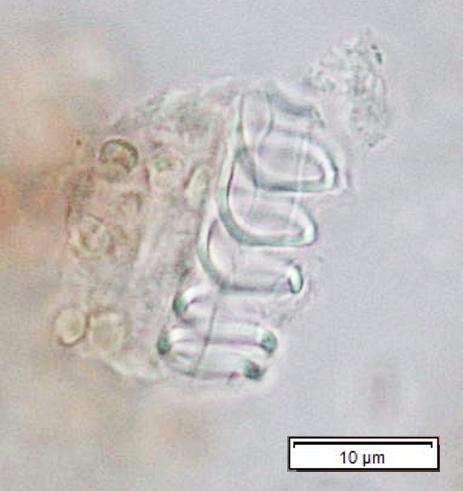


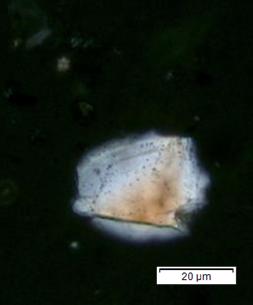


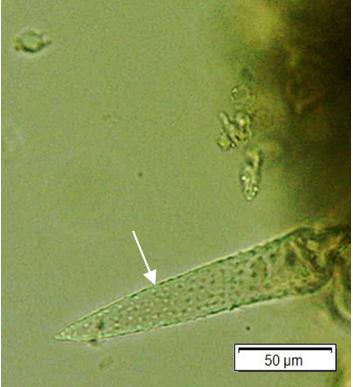

Figure 2 : Microscopic characters of P. amboinicus leaves powder of 0.355 mm size. (a) Parenchyma cells (magnification 20×); (b) stomata cells (red arrow) (magnification 40×); (c) spiral vessel fragment (magnification 40×); (d) annular vessel fragment (magnification 40×); (e) druses calcium oxalate crystal (white arrow) (magnification 40×); (f) solitary calcium oxalate crystal (magnification 10×); (g) capitate glandular trichomes (terminal: tapering and multicellular) (magnification 40×); (h) capitate glandular trichome cells (terminal rounded in side view) (magnification 20×); (i) non glandular trichome (simple, unicellular) with echinate ornamentation (white arrow) (magnification 20×); (j) oil glands (red arrow) (magnification 40×). [Scale bars: b, c, d, e, g, j = 10 µm; f = 20 µm; a, h, i = 50 µm]
Thin Layer Chromatography (TLC)
| Test solution | Weigh about 250 g of P. amboinicus dried leaves powder of 0.355 mm size in a 5 L of round bottom flask. Add 2.5 L of water. Distill for 4 hrs using Clavenger apparatus. Collect the oil in a suitable vial. Dissolve 10 µL of the oil in 1 mL ethanol using a vortex for 10 secs. |
| Standard solution | Dissolve carvacrol standard (CAS no.: 499-75-2) in ethanol to produce a standard concentration of 10 µL/mL. |
| Stationary phase | HPTLC Silica gel 60 F254, 10 x 10 cm |
| Mobile phase | Toluene : ethyl acetate; (99 :1),(v/v) |
| Application |
|
| Development distance | 8 cm |
| Drying | Air drying |
| Detection |
|
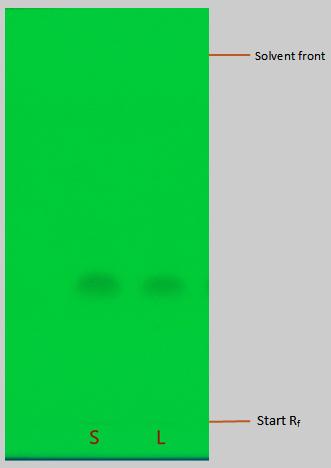
Figure 3 : TLC chromatogram of carvacrol (S), essential oil of P. amboinicus dried leaves powder (L) observed under UV at 254 nm before derivatisation.
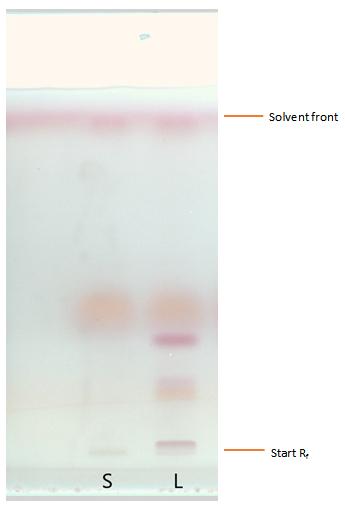
Figure 4 : TLC chromatogram of carvacrol (S), essential oil of P. amboinicus dried leaves powder (L) observed under visible light after derivatisation.
High Performance liquid Chromatography (HPLC)
| Test solution | Weigh about 250 g of P. amboinicus dried leaves powder of 0.355 mm size in a 5 L of round bottom flask. Add 2.5 L of water. Distill for 4 hrs using a Clavenger apparatus. Collect the oil in a suitable vial. Dissolve 1 µL of the oil in 10 mL ethanol using a vortex for 10 secs. | |||||||||||||||||||||
| Standard solution | Dissolve carvacrol standard [CAS no: 499-75-2] in ethanol to produce a standard concentration 0.2 µL/mL. | |||||||||||||||||||||
| Chromatographic system |
Detector: 275 nm |
|||||||||||||||||||||
| Mobile phase (gradient mode) |
|
|||||||||||||||||||||
| System suitability requirements |
Perform at least five replicate injections of the standard solutions (0.2 µL /mL). The requirements of the system suitability parameters are as follow:
|
|||||||||||||||||||||
| Acceptance criteria |
|

(a)

(b)
Figure 5 : Whole HPLC chromatogram of (a) carvacrol standard solution (0.2 µL/mL) at tr= 12.15 min and (b) essential oil of P. amboinicus dried leaves powder showing peak corresponding to carvacrol standard solution at tr= 12.10 min.

(a)

(b)
Figure 6 : HPLC chromatogram highlighting the elution region of (a) carvacrol standard solution (0.2 µL/mL) at tr= 12.15 min and (b) essential oil of P. amboinicus dried leaves powder showing a peak corresponding to carvacrol standard solution at tr= 12.10 min.
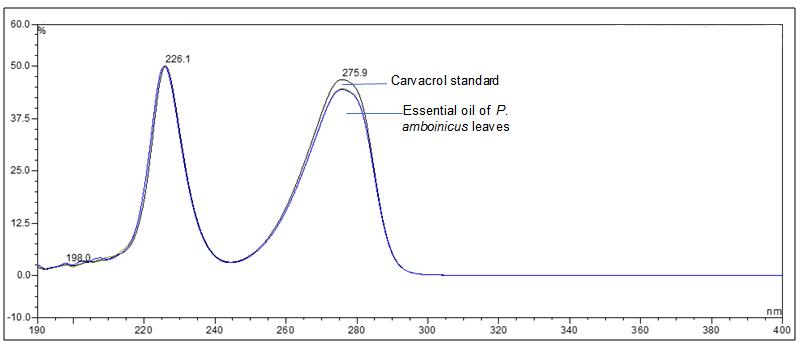
Figure 7 : UV spectra of carvacrol standard solution (0.2 µL/mL) and essential oil of P. amboinicus dried leaves powder.
PURITY TEST
The purity tests, except foreign matter test are based on P. amboinicus dried leaves powder of 0.355 mm particle size.
| Foreign Matter |
| Not more than 2% |
| Ash Contents | |
| Total ash | Not more than 22% |
| Acid-insoluble ash | Not more than 2% |
| Water soluble ash | Not less than 5 % |
| Loss on Drying |
| Not more than 12% |
| Extractive Values | |
| Water-soluble extracts | |
| Hot method | Not less than 33% |
| Cold method | Not less than 29% |
| Ethanol-soluble extracts | |
| Hot method | Not less than 8% |
| Cold method | Not less than 3% |
SAFETY TEST
The safety tests are based on P. amboinicus dried leaves powder of 0.355 mm particle size
| Heavy Metals | |
| Arsenic | Not more than 5.0 mg/kg |
| Mercury | Not more than 0.5 mg/kg |
| Lead | Not more than 10.0 mg/kg |
| Cadmium | Not more than 0.3 mg/kg |
| Microbial Limits | |
| Total bacterial count | Not more than 105 cfu/g |
| Total yeast and mould count | Not more than 104 cfu/g |
| Bile-tolerant gram negative | Not more than 104 cfu/g |
| Specific Pathogens | |
| Salmonella spp. | Absent in 25 g |
| Escherichia coli | Absent in 1 g |
| Staphylococcus aureus | Absent in 1 g |
| Pseudomonas aeruginosa | Absent in 1 g |
CHEMICAL CONSTITUENTS
Essential oil of P. amboinicus fresh leaves was found to contain phenylpropene (e.g. myristicin), terpenes (e.g. carvacrol, thymol, α-pinene, α-thujene, 1- epi-cubenol, α- terpineol, linalool), sesquiterpenoids (e.g. β-carophyllene, δ-cadinene, γ-cadinene, α-cubebene, calamenene, (Z)-β-farnesene, (E)-β-farnesene, α-cadinol,cubenol, T-muurolol), monoterpenes (e.g. β-pinene, camphene, sabinene, δ-3-carene, myrcene, α-phellandrene, α-terpinene, limonene, β-phellandrene, (Z)β-ocimene, (E)β-ocimene,γ-terpinene, p-cymene, terpinolene, α-fenchone, carvacryl acetate), sesquiterpenes (e.g. β-elemene, α-humulene, α-selinene, β-selinene, β-sesquiphellandrene, trans- β-bergamotene, β-bisablone, α-copaene, caryophyllene oxide), terpenoid (e.g. camphor), and alcohol (e.g. 3 octanol, 1-octen-3-ol) [6, 7, 8, 9].
Ethanol extract of P. amboinicus dried leaves was found to contain phenolics (e.g. quinic acid, ferulic acid, vanillic acid, syringic acid, caffeic acid, methyl gallate, procatechuic acid, caffeoylquinic acid, ellagic acid, salicylic acid glucoside, sinapic acid hexose and vicenin-1) [10].
Methanol extract of P. amboinicus leaves was found to contain terpenes (e.g. carvacrol, thymol, cineole), monoterpenes (e.g. limonene, pinene), and phenolics (e.g. syringic acid and vanillin [11].
MEDICINAL USES
Uses described in folk medicine, not supported by experimental or clinical data
Traditionally, the leaves from P. amboinicus are boiled with rock sugar to relieve coughing. Leaves boiled with water is consumed to reduce flatulence. The leaves were also used as an ingredient in a bath concoction for after childbirth [3].
Biological and pharmacological activities supported by experimental data
Antioxidant activity
Aqueous extract of P. amboinicus leaves (500 μg/mL) showed 91% antioxidant activity compared to butylated hydroxytoluene (BHT) (200 μg/mL) with 95% antioxidant activity using β-carotene-linoleate assay [12].
Essential oil of P. amboinicus leaves exhibited 88% antioxidant activity at concentration of 200 ppm compared to butylated hydroxyl anisole (BHA) (500 ppm) using 1.1-diphenyl 2-picrylhydrazyl (DPPH) assay [9].
Ethyl acetate extract of P. amboinicus leaves showed 54% antioxidant activity at concentrations of 100 ppm compared to (100 ppm) BHA (96%) using DPPH assay [13].
Anti-inflammatory activity
Ethanol (70%) extract of P. amboinicus leaves (150, 250, and 350 mg/kg) were administered orally to carrageenan-induced Wistar albino female rats (250 ± 50 g). The extract of 250 mg/kg significantly (p < 0.05) reduced paw edema volume by 41% at 3 hours treatment compared to indomethacin (10 mg/kg) [14].
Antiproliferative activity
Methanol extract of P. amboinicus dried leaves caused growth inhibition of immortalised human embryonic kidney (HEK) 293 cell line in a dose-dependent manner using 3-(4,5-dimethylthiazol-2-yl)-2,5 diphenyltetra-zolium bromide (MTT) assay. The 50% cytotoxic concentration (CC50) value for the extract is 27.56 μg/mL as compared to positive control, bevacizumab with CC50 of 15.32 μg//mL [11].
Clinical studies
Information and data have not been established.
SAFETY INFORMATION
Preclinical studies (Toxicology studies)
Information and data have not been established.
Others (Adverse reactions, contraindications, side effects, warning, precautions)
Information and data have not been established.
DOSAGE
Information and data have not been established.
STORAGE
Store below 30°C. Protect from light and moisture.
REFERENCES
- The Plant List. [Internet] Plectranthus amboinicus. Version 1.1; [cited on 2nd October 2020]. Available from: http://www.theplantlist.org/tpl1.1/record/kew-157885.
- Singapore National Parks Board, Flora, and Fauna Web. [Internet] National Parks Board; [cited on 14th July 2022]. Available from: https://www.nparks.gov.sg/florafaunaweb
- Mustapha NMA, Mahmood NZN, Ali NAM, Haron N. Khazanah Perubatan Melayu: Tumbuhan Ubatan. Jilid 1: Institut Penyelidikan Perhutanan Malaysia 2017; p.36-37. ISBN 978-967-0622-89-7.
- Multilingual Multiscript Plant Name Database. [Internet] The University of Melbourne; [cited on 15th July 2022]. Available from: https://www.plantnames.unimelb.edu.au/Sorting/Plectranthus.html
- Ayurvedic Medicinal Plants of Sri Lanka Compendium Version 3. [Internet] The Institute of Ayurveda and Alternative Medicine (IAAM) of Barberyn Ayurveda Resorts; [cited on 15th July 2022]. Available from: http://www.instituteofayurveda.org/plants/plants_detail.php?i=727&s=Local_name
- Jugreet BS, Mahomoodally MF, Sinan KI, Zengin G, Abdallah HH. Chemical variability, pharmacological potential, multivariate and molecular docking analyses of essential oils obtained from four medicinal plants. Industrial Crops and Products. 2020; 150:112394.
- Jugreet BS, Mahomoodally MF. Essential oils from 9 exotic and endemic medicinal plants from Mauritius shows in vitro antibacterial and antibiotic potentiating activities. South African Journal of Botany. 2020; 132:355-62.
- Teixeira AMR, Lima IKC, Xavier MR, Pereira RLS, Gonçalves BG, de Sena DM, et al. Vibrational spectroscopy study of essential oils from Plectranthus amboinicus Lour. Spreng and Vanillosmopsis arborea Baker. Vibrational Spectroscopy. 2018; 98:22-9.
- Murthy PS, Ramalakshmi K, Srinivas P. Fungitoxic activity of Indian borage (Plectranthus amboinicus) volatiles. Food Chemistry. 2009;114(3):1014-8.
- Sulaiman CT, Deepak M, Balachandran I. Spectrophotometric and tandem mass spectroscopic analysis of Indian borage (Plectranthus amboinicus (Lour.) Spreng.) for its polyphenolic’s characterization. Beni-Suef University Journal of Basic and Applied Sciences. 2018;7(4):471-3.
- Sindhu MS, Poonkothai M, Thirumalaisamy R. Phenolic and terpene compounds from Plectranthus amboinicus (Lour.) Spreng. Act as promising hepatic anticancer agents screened through in silico and in vitro approaches. South African Journal of Botany. 2022; 149:145-59.
- Kumaran A, Joel Karunakaran R. Antioxidant and free radical scavenging activity of an aqueous extract of Coleus aromaticus. Food Chemistry. 2006;97(1):109-14.
- Bhatt P, Negi PS. Antioxidant and antibacterial activities in the leaf extracts of indian borage. Food and Nutrition Sciences. 2012;03(02):7.
- Gurgel APAD, da Silva JG, Grangeiro ARS, Oliveira DC, Lima CMP, da Silva ACP, et al. In vivo study of the anti-inflammatory and antitumor activities of leaves from Plectranthus amboinicus (Lour.) Spreng (Lamiaceae). Journal of Ethnopharmacology. 2009;125(2):361-3.


